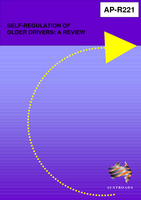Road Safety

Self-Regulation of Older Drivers: A Review
- Publication no: AP-R221-03
- ISBN: 0 85588 649 8
- Published: 4 March 2003
- PDF (free) Download
Drivers aged 65 years and over are over-represented in serious injury and fatal crashes in this country and elsewhere and these figures are expected to increase up to threefold with the projected increase in the proportion of the elderly in the population. It is unclear, however, whether these crash data reflect over-exposure to risky situations, the frailty of the elderly, their driving behaviour, or other factors. On the whole, older drivers are considered a safe and cautious group, however, as people age, there are declines in sensory, cognitive and motor skills that can affect the ability to drive safely. It seems that, for the most part, older drivers compensate for these changes by driving less, avoiding driving at night, in bad weather, in heavy traffic or in difficult or high risk situations, travelling only in familiar areas and travelling at lower speeds. The ability of older drivers to regulate their driving according to their functional skills, to continue driving only in a safe manner and cease driving when they feel they are no longer able to drive safely, are important skills. While these adjustments in driving behaviour may be regarded as compensatory strategies to accommodate their changing abilities, it may also be an artefact of other lifestyle changes. It is also possible, that there is a sub-set of this group that may be unable to self-regulate their driving adequately and are therefore at higher risk of crash involvement. The purpose of this report is to review current literature on driving reduction, restriction and cessation. It identifies and discusses factors that may influence the process of self-regulation and eventual cessation of driving, including the role of educational programs aimed to improve the effectiveness of this practice for older drivers. The review suggests that there are serious gaps in our knowledge about the incidence and process of self-regulation in this country and about the effectiveness of self-regulatory practic
- SELF-REGULATION OF OLDER DRIVERS: A REVIEW
- CONTENTS
- EXECUTIVE SUMMARY
- 1. INTRODUCTION
- 2. THE AGEING POPULATION
- 3. OLDER DRIVER CRASHES
- 4. THE IMPORTANCE OF DRIVING
- 5. LICENSING ISSUES
- 6. SELF-REGULATION
- 7. EDUCATION
- 8. PROPOSAL FOR MUARC’S WORK
- 9. CONCLUSIONS
- REFERENCES
- INFORMATION RETRIEVAL
Related publications
WEB-ZRT-24
Latest Road Safety News
